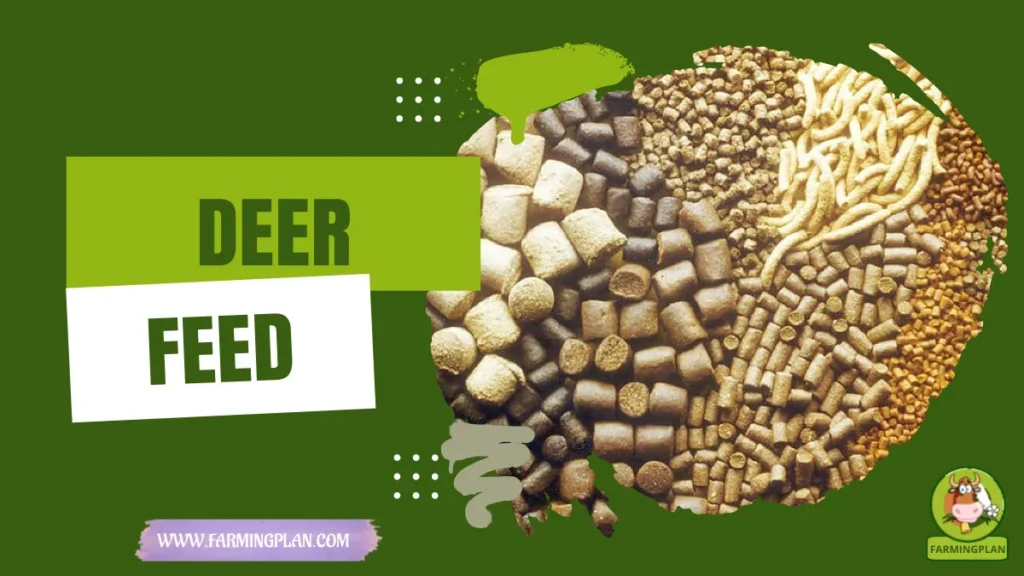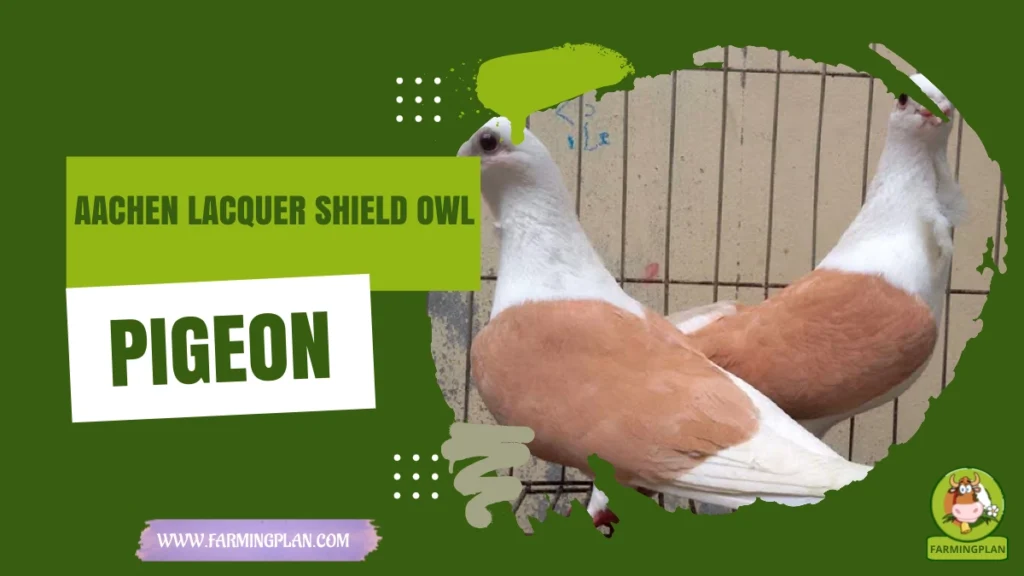If you’re looking for a draft horse with raw power, a calm heart, and a face you’d trust in a battlefield or barn, let me introduce you to the Ardennes Horse. I’ve had the pleasure of working with these muscular beauties, and they’re not just heavy lifters—they’re sweet, dependable companions that can turn hard farm work into something almost enjoyable. Known for their bulky build and gentle nature, the Ardennes fits in anywhere—whether pulling carts, grazing in the pasture, or even starring in video games like RDR2. In this guide, I’ll walk you through everything I’ve learned about raising, feeding, and caring for Ardennes horses—based on real experience, not just textbook facts.
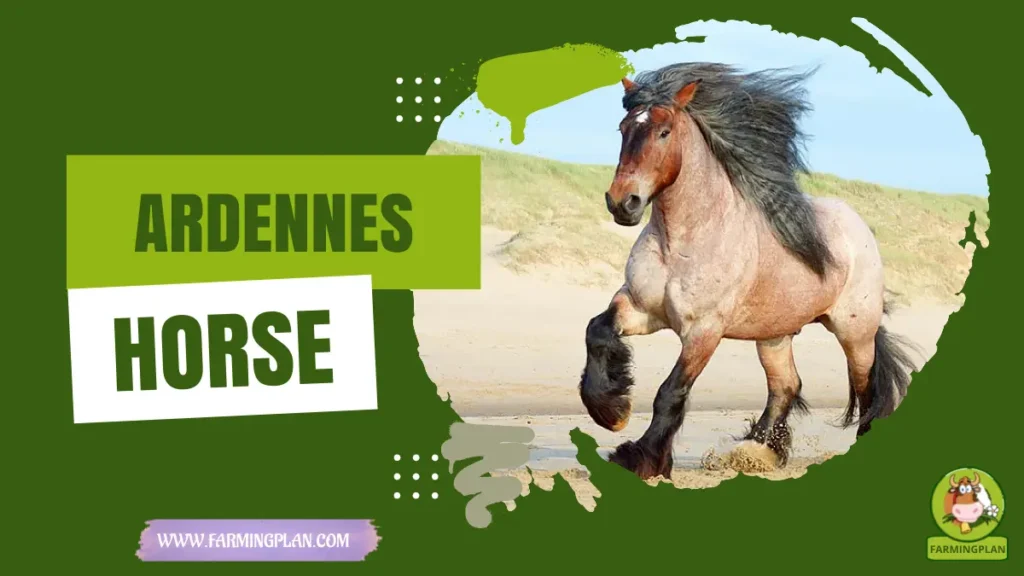
History & Origin of the Ardennes Horse
These horses have a history that stretches back to the 11th century, a testament to their enduring strength and resilience. The Ardennes Horse hails from the rocky regions of the Ardennes in Belgium, Luxembourg, and France, where farmers and soldiers relied on their robust nature to pull loads, plows, and even artillery. By the time the 17th and 18th centuries rolled around, Ardennes horses were already earning respect across Europe for their strength and endurance. They were used in Napoleon’s Russian campaign as war horses and later became prized artillery horses.
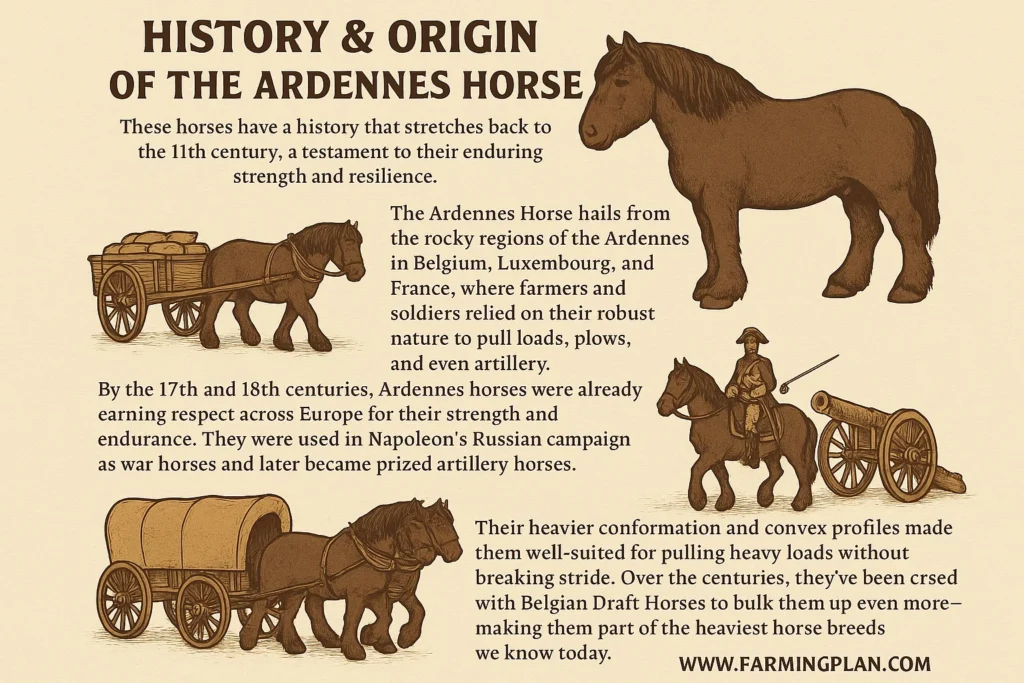
What really sets them apart, though, is how they never lost their cool—even while pulling wagons through the winter retreat or trudging across battlefields. Their heavier conformation and convex profiles made them well-suited for pulling heavy loads without breaking stride. Over the centuries, they’ve been crossed with Belgian Draft Horses to bulk them up even more—making them part of the heaviest horse breeds we know today.
Characteristics of the Ardennes Horse
The Ardennes Horse is not just strong—it exudes strength. These horses are a sight to behold, with their compact body, sturdy legs, and lush feathering. Their robust build makes them ideal for long work hours without tiring easily. They boast a short but wide neck, a powerful chest, and a strong back that can carry or pull just about anything. When it comes to Ardennes horse height, most stand between 15 and 16 hands tall. Their weight usually ranges from 1,500 to over 2,200 pounds. Despite their size, they’re surprisingly graceful on their feet and carry themselves with pride.
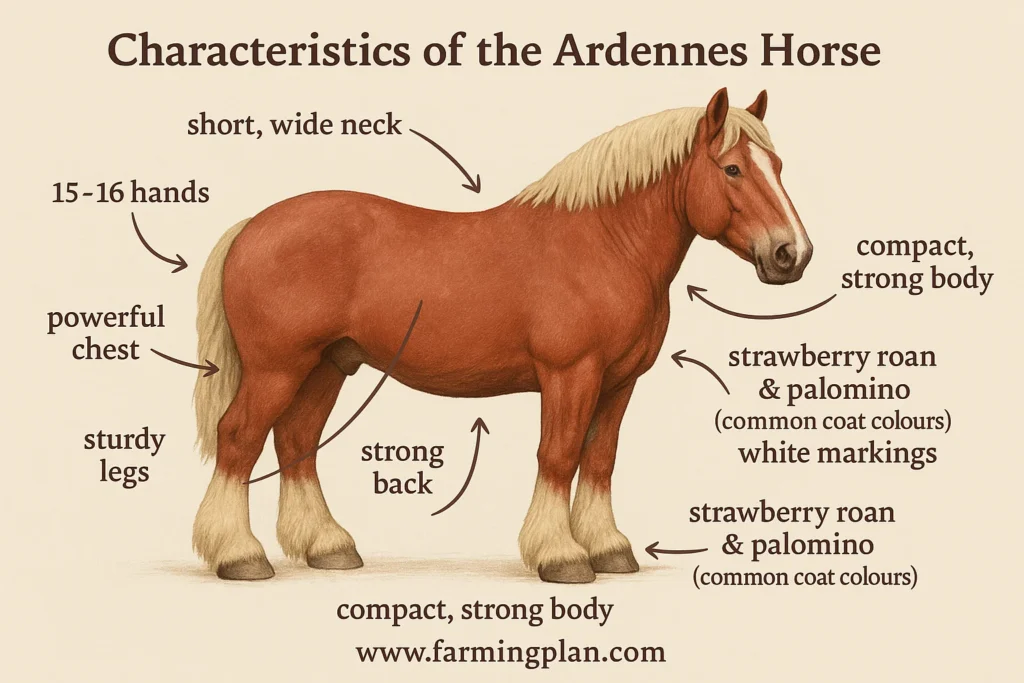
I’ve worked with both Strawberry Roan Ardennes and palomino types, and let me tell you—those common coat colours aren’t just beautiful, they’re also incredibly easy to maintain with the right grooming routine. Their white markings and feathered legs give them a noble, almost medieval look, and I love that their strength doesn’t take away from their charm. You’ll see right away why they were often used as war horses and wagon train leaders.
Read More: Haflinger Horse: Stunning, Calm & Versatile
Temperament of the Ardennes Horse
Let’s talk about personality. The Ardennes might look like a tank, but it’s got the temperament of a golden retriever. These horses are calm, patient, and incredibly easy to work with—even for beginners. I’ve never met a more loyal partner when it comes to hauling gear or just standing quietly while I get my tools together. Because of their chill nature, Ardennes horses are great for farmers, hobbyists, and breeders looking for dependable animals. They’re also good with kids (though not quite pony material) and can be trained for a variety of farm jobs. Their relationships in horse breeds show just how compatible they are with other animals too.
They’re especially useful for folks who need a heavier horse without the unpredictable temperament you sometimes find in light horse breeds. They respond well to routine, and with a little encouragement and a few treats, they’ll follow you anywhere. However, training an Ardennes horse can be a time-consuming process, so be prepared to invest the necessary time and effort.
Food & Diet of the Ardennes Horse
Feeding an Ardennes is a balancing act—you’ve got to keep them strong without making them overweight. Since they’re naturally bulky, you’ll want to watch their body condition score closely. I always use a mix of high-quality hay, grains in moderation, and a vitamin supplement that keeps their coat health in top shape. These horses do well on draft horse feed plans, but they can be a bit messy. I’ve seen some of mine take in extra dirt while grazing, so I make sure their hay stays off the ground to prevent dirt intake. Clean feeders and daily fresh water are non-negotiable.
Avoid overfeeding grains—it can lead to muscle issues or founder. Stick with about 1.5–2% of their body weight in hay daily and throw in some flaxseed or oil if their coat starts to dull. And yes, they love apples… but don’t go overboard on the snacks!
Usage & purpose of the Ardennes Horse
What can’t these horses do? Historically, they were bred for war—hauling artillery, carrying knights, and holding strong through some of the worst winters in Europe. But today, you’ll find Ardennes horses pulling plows, working in logging camps, and starring in draft horse competitions. I’ve used mine for everything from pulling farm equipment to giving wagon rides at fall festivals. Their bulky body and calm attitude make them ideal for work that would tire out most breeds. Some folks also raise them as meat animals, though I personally keep mine for work and companionship.

The Ardennes Horse’s adaptability is unparalleled. Whether you’re a small pet owner or running a full-scale farm, the Ardennes is a reliable choice for horse lovers who need strength, patience, and versatility in one hefty package.
Special Features of the Ardennes Horse
Here’s where the Ardennes really shines. First off, their extensive musculature makes them one of the most powerful horse breeds in the world. They’ve got a dense bone structure, and that lush leg feathering isn’t just for show—it protects their legs from brush and mud, especially in colder months. They also have a compact body structure that helps distribute weight evenly, which is why they’re so efficient in pulling heavy loads. You won’t see them getting winded easily, and their coat is often thick enough to handle colder climates without blankets.
Another unique trait? Their heart. No, really—these horses give it their all. I’ve had one pull a wagon through deep mud for nearly an hour and still nuzzle me for a carrot afterward. That’s the kind of grit and gentleness you can’t train—it’s just in their blood.
Read More: Friesian Horse Drama – The Majestic Joy And Hidden Challenges
Health Issues & Prevention: Keep Your Ardennes Thriving
While Ardennes horses are generally healthy animals, they’re not totally immune to trouble. Like most heavy draft breeds, they can develop hoof issues, especially if they’re working in wet or rocky environments. I always keep their hooves trimmed every 6–8 weeks and check for signs of thrush or cracks. Another thing to watch for is skeletal muscle strain from overworking or poor terrain. Regular muscle massages (yes, that’s a real thing) and rest days go a long way. Keeping their body condition score in check will help avoid obesity-related problems.
Because of their feathered legs, I recommend grooming them at least twice a week to prevent mud rash or fungal infections. A good brushing and a quick coat check after each workday can save you a vet bill down the road.
Big Horses Need Big Love—Raise Your Ardennes With Patience, Purpose, And A Little Bit Of Mud On Your Boots.
Step-by-Step Farming Guide: Raising an Ardennes Horse
Learn how to raise a powerful and gentle Ardennes Horse with this easy, step-by-step guide. From building the right shelter to selecting a healthy horse, feeding properly, grooming those signature feathers, and training with patience—this guide covers everything you need. Whether you’re a hobbyist or a farmer, these draft horses thrive when cared for right. Discover practical tips that make Ardennes horse farming rewarding and stress-free.
Step 1: Build a Draft-Ready Shelter & Safe Paddock
The Ardennes is no pony—stall space should be no less than 14×14 ft to accommodate their bulk (they average 1,500–2,200 lbs). I built mine with a 10-foot ceiling, solid kickboards, and thick straw bedding. Good ventilation is essential to avoid respiratory issues common in heavy breeds.
Outdoors, paddocks should be at least half an acre per horse, with fencing that’s a minimum of 5 feet high. Avoid barbed wire; use electric tape or wood for safety. Proper drainage is crucial—Ardennes tolerate cold, but wet footing causes thrush and laminitis. Sloped flooring, gravel bases, and stall mats work wonders to keep hooves dry.
Step 2: Choose a Sound, Well-Bred Ardennes
A healthy Ardennes should have a broad chest, deep girth, short cannon bones, and a calm expression. Average height ranges from 15 to 16.2 hands. Always check for clean limbs, a steady gait, and symmetrical muscle tone.
Ask the breeder for vaccination records, deworming schedule, and hoof care history. The breed is known for feathered legs—lift those feathers and check for mites or fungal infections. I never skip listening to their breathing either—heavy breeds can develop chronic obstructive pulmonary disease (COPD) if overworked or housed poorly. Choose one that stands quietly and interacts confidently—trainability starts with temperament.
Step 3: Feed for Strength, Not Size Alone
Ardennes horses need about 1.5%–2% of body weight in roughage daily, meaning up to 40 pounds of hay for a 2,000 lb adult. I mix in alfalfa when they’re doing fieldwork or hauling, to support muscle recovery.
Avoid corn or sweet feed—these lead to equine metabolic syndrome. I use a ration balancer and trace mineral block year-round. Clean water? Non-negotiable. Especially in summer, these horses sweat more than lighter breeds and need constant hydration. In cold months, I feed soaked beet pulp and offer warm mash on chilly mornings. Keeps their gut moving and their spirits high.
Step 4: Groom for Health and Bonding
Ardennes horses grow dense winter coats and have heavy feathering, so grooming is serious business. I groom three times a week, and at least once fully. Use a dandy brush for the body and a slicker or metal comb for feathers. Look for signs of “scratches” or pastern dermatitis—it’s common in moist conditions under the feathering. Finish with a mane detangler and a hoof pick. I apply hoof conditioner in dry weather and check for heat or cracking. Don’t rush grooming—it’s bonding time too. They’ll remember how you treat them. A happy Ardennes shines—literally and emotionally.
Step 5: Train With Patience and Positivity
The Ardennes has a willing heart but a slow-maturing brain—they reach full mental and physical maturity around 5–6 years. I start groundwork young, using repetition, soft voice cues, and light lead pressure. These horses respond best to routine and consistency. Don’t expect quick results. Use 15-minute sessions, 3–4 times a week to build trust. For pulling or harness work, begin with empty carts or logs and increase resistance gradually. Always end on a win—whether it’s just a good “whoa” or backing up a step. Trust me, they never forget a kind trainer—or a rude one.
Expert Tips & Best Practices
- Tip: Always Brush The Feathering With Care—It’s Beautiful, But It Hides Dirt Like A Pro!
- Use deep bedding in stalls to prevent hoof soreness.
- Monitor hay for mold—these big guys eat a lot, but not everything!
- Try low-sugar, high-fiber treats.
- Rotate pastures to manage weight and avoid overgrazing.
Read More: Percheron Horse: Why This Powerful Breed Might Surprise You
FAQ
How much does an Ardennes horse cost?
An Ardennes horse usually costs between $3,000–$8,000, depending on training, age, and location.
What is the typical height and weight of an Ardennes horse?
They stand around 15–16 hands tall and weigh 1,500–2,200 lbs.
What colors are Ardennes horses found in?
You’ll often see bay, chestnut, palomino, and roan, especially the Strawberry Roan Ardennes.
Are Ardennes horses available in Red Dead Redemption 2?
Yes, they’re a popular war horse in RDR2 thanks to their strength and stamina.
Are Ardennes good for beginner horse owners?
Absolutely. Their calm nature and loyalty make them a favorite among new farmers and hobbyists.
Conclusion
The Ardennes Horse brings a powerful mix of muscle, loyalty, and heritage that’s hard to beat. Whether you’re plowing fields, working on a hobby farm, or just want a gentle giant in your barn, this breed offers a lifetime of value and companionship. With the right care, feeding, and daily attention, these horses don’t just survive—they thrive.

